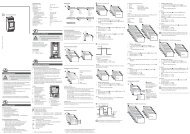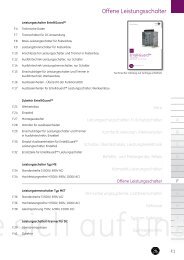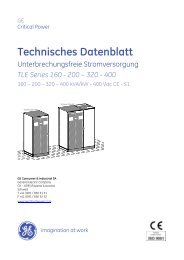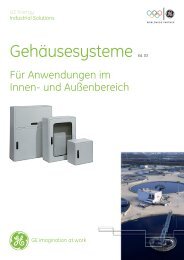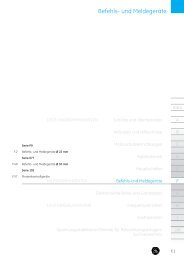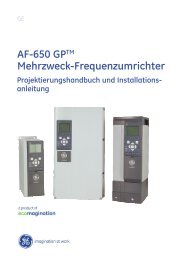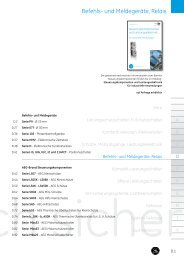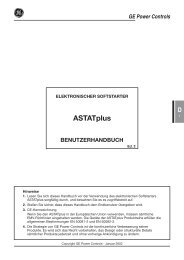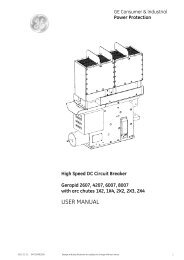High Speed DC Circuit Breaker - G E Power Controls
High Speed DC Circuit Breaker - G E Power Controls
High Speed DC Circuit Breaker - G E Power Controls
Create successful ePaper yourself
Turn your PDF publications into a flip-book with our unique Google optimized e-Paper software.
3.2.5 Electro-Dynamic tripping device (code nr: 12)<br />
• ED tripping device requires an external protective relay/system<br />
for monitoring a current increase. This relay/system<br />
belongs to customer’s installation.<br />
• If a fault occurs, an external relay, releases signal into<br />
the capacitors’ control unit (internal NEKO or external),<br />
which discharges abruptly its energy into ED coil [Fig. 8].<br />
The coil trips the breaker’s quick latch and cause opening<br />
within time of less 3ms.<br />
• ED tripping device is offered as an option. Standard set<br />
consist of ED coil and electronic control unit with C-bank<br />
installed in (NEKO). The external release signal shall have<br />
6V to 24V <strong>DC</strong>, and shall be fed at (-X2 :10 / :11).<br />
• Customer may use it’s own C-bank unit. Rated voltage of<br />
300V<strong>DC</strong> and capacity of 2000uF is required. In this case<br />
only ED coil will be installed into the breaker.<br />
• Be sure, that voltage level is between 6V…24V and<br />
there are no spikes on signal with duration 3V. In these cases UVR trips the breaker. It is therefore<br />
possible to use this device in combination with the electronic<br />
trip unit for voltage monitoring, i.e. for motor<br />
switches, where an unintended re-start of machines after<br />
a temporary voltage breakdown is to be prevented.<br />
• The UVR is intended for continuous operation. Its rated<br />
power is 40W.<br />
• Due to their operational mode, UVR is self-monitoring<br />
device, i.e. when the breaker is tripped upon a break of<br />
the pilot wire (EMERGENCY-OFF principle).<br />
Fig. 9 Zero voltage release<br />
3.2.7 Forced tripping release (code nr: 13)<br />
Fig. 8 ED tripping coil with seesaw interface<br />
• Optionally, the forced tripping release (FTU) can be installed<br />
in the breaker [Fig. 10a]. This unit is used for mechanical<br />
tripping of the breaker, by means of pressing<br />
the pin at the bottom plate. Force required to trip the<br />
breaker is about 300N (~67,5 lbf).<br />
• The tripping pin position is as on Fig. 10b.<br />
3.2.6 Auxiliary tripping devices (code nr: 11).<br />
• The breaker can be equipped with either a shunt trip (ST)<br />
or a zero voltage release (UVR). It is not possible to have<br />
both devices installed in the same breaker.<br />
• In standard configuration, internal voltage converter<br />
(code nr: 8), supply the devices with 24V<strong>DC</strong>. This converter<br />
transforms any externally connected voltage, into<br />
internal 24V<strong>DC</strong>, required by breaker’s controls.<br />
• Optionally, it’s possible to supply both devices with direct<br />
external 24V<strong>DC</strong> ± 5%. In this case release signal for ST<br />
shall not be longer 100ms.<br />
• Both devices are tripped by potential free contact connected<br />
accordingly.<br />
• Both devices are interchangeable.<br />
• The ST is used for remote actuation. It is designed for<br />
short time operation with maximum duty cycle of 9%.<br />
ST’s supply is connected through the auxiliary contact,<br />
which cut off supply voltage after breaker’s opening.<br />
This protects ST against overheating.<br />
Fig. 10a Forced tripping release<br />
(~0,6 in)<br />
(~0,3 in)<br />
8 Design and specifications are subject to change without notice S47183-e 01/2008





